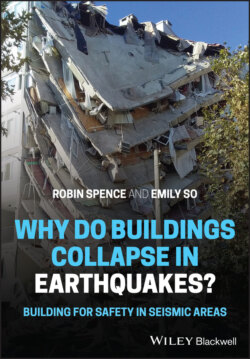Читать книгу Why do buildings collapse in earthquakes? Building for safety in seismic areas - Robin Spence - Страница 29
2.5 Are Earthquake Losses Decreasing Over Time?
ОглавлениеIn order to investigate whether earthquake losses are decreasing over time, we need to look at both human casualties and damage costs. Both need to be viewed from a longer‐term perspective than just the 20 years which has been the focus of this chapter so far. Because most of the damage and casualties occur in just a few earthquakes, it is better to assemble the loss data by decade.
Reasonably reliable data on human casualties are available from about 1900 onwards, using a variety of catalogues, and this has been assembled and maintained by our colleague Antonios Pomonis (Daniell et al. 2018). The chart shown in Figure 2.20 is based on these data. Because the world's population has been growing rapidly in this period, it is important to take account of this increase in comparing the number of deaths over time. Figure 2.20 shows the earthquake mortality rate in each decade since 1900, where the mortality rate is the estimated number of deaths per 100 000 of the world's population in the mid‐year of the decade. Data on serious injuries are also available for many events, but injury definitions vary, so these are less useful for long‐term comparisons.
Figure 2.19 Earthquake damage and fatalities by country 2000–2019, using a logarithmic scale based on EM‐DAT Disasters Database (CRED 2020). Note: this chart excludes events in which the majority of deaths were related to tsunami rather than ground shaking.
Source: Data from CRED (2020).
Figure 2.20 Global earthquake mortality rate since 1900 (deaths per 100 000 population).
Source: Data from Antonios Pomonis's Fatal Earthquakes database.
Figure 2.20 shows that the mortality rate has been decreasing to some extent over the last 120 years, as indicated by the trendline. But the decline is slow and actual mortality rates vary enormously from decade to decade.
There are some reasons for thinking that this positive downward trend will continue. Fire following earthquakes is a smaller risk than it was, because of changes in building materials and fire protection. And there is also evidence that in many countries, there is increasing adherence to building codes partly as a result of greater public awareness of the earthquake risk. And specific building strengthening programmes have been undertaken in some countries (see Chapter 8). On the other hand, as Roger Musson has noted in his book The Million Death Quake (Musson 2012), the continuing concentration of global population into huge cities with extremely vulnerable housing is increasing the risks in many of them, and has given rise to the possibility of a single future earthquake which could cause more than a million deaths, a much higher death toll than has occurred to date in a single event. The most at‐risk cities can now be identified, and efforts are being made in many of them to improve construction standards. Future trends in the mortality rate will depend crucially on what can and is being achieved in these cities. A further factor which could influence future death rates is the rapid increase of population in coastal areas (A. Pomonis, 2020, personal communication). Daniell et al. (2012) also points out that there has been, over the period 1900–2012, an increase in earthquake deaths as a percentage of total deaths, suggesting that greater success has been achieved in reducing death rates from other causes.
The costs of earthquake damage have also been assembled for over 7000 damaging earthquakes since 1900 in the CATDAT database by James Daniell and co‐workers at KIT in Karlsruhe in Germany, and the trends in losses up to 2012 have been analysed (Daniell et al. 2012). Costs of earthquakes are usually divided into direct and indirect costs. The direct costs are those associated with the actual damage caused by the earthquake, while the indirect costs (which are more difficult to quantify) are those associated with loss of production and overall economic consequences of the event. To compare the losses over time, costs have been brought to a present value. The adjustment is to bring all costs to the values that would be paid in today's money for the event‐year earthquake effects. The total (direct and estimated indirect) earthquake losses have then been calculated as a percentage of GWP, the Gross World Product (the world's total economic output), also adjusted to present‐day values, to give an annual global loss rate.
The surprising conclusion is reached that, although the global annual loss rate has fluctuated somewhat over time, the trend has remained relatively constant, with a peak of 0.1% in 1949, reducing in more recent years to about half of this value. Thus, while production and population have increased enormously over the last century, and thus actual values of loss have increased correspondingly, there has been only a small decrease in the loss rate as a proportion of GWP. But this decrease is not enough to suggest that the problem of economic earthquake losses is being brought under control. For small poor countries such as Haiti, the total cost of a single event can be more than 100% of the country's GDP. Indeed, recent events have suggested that, given the increasing interconnectedness of the world's economy, the indirect losses are increasing and will become more dominant in future events (Daniell et al. 2012).
